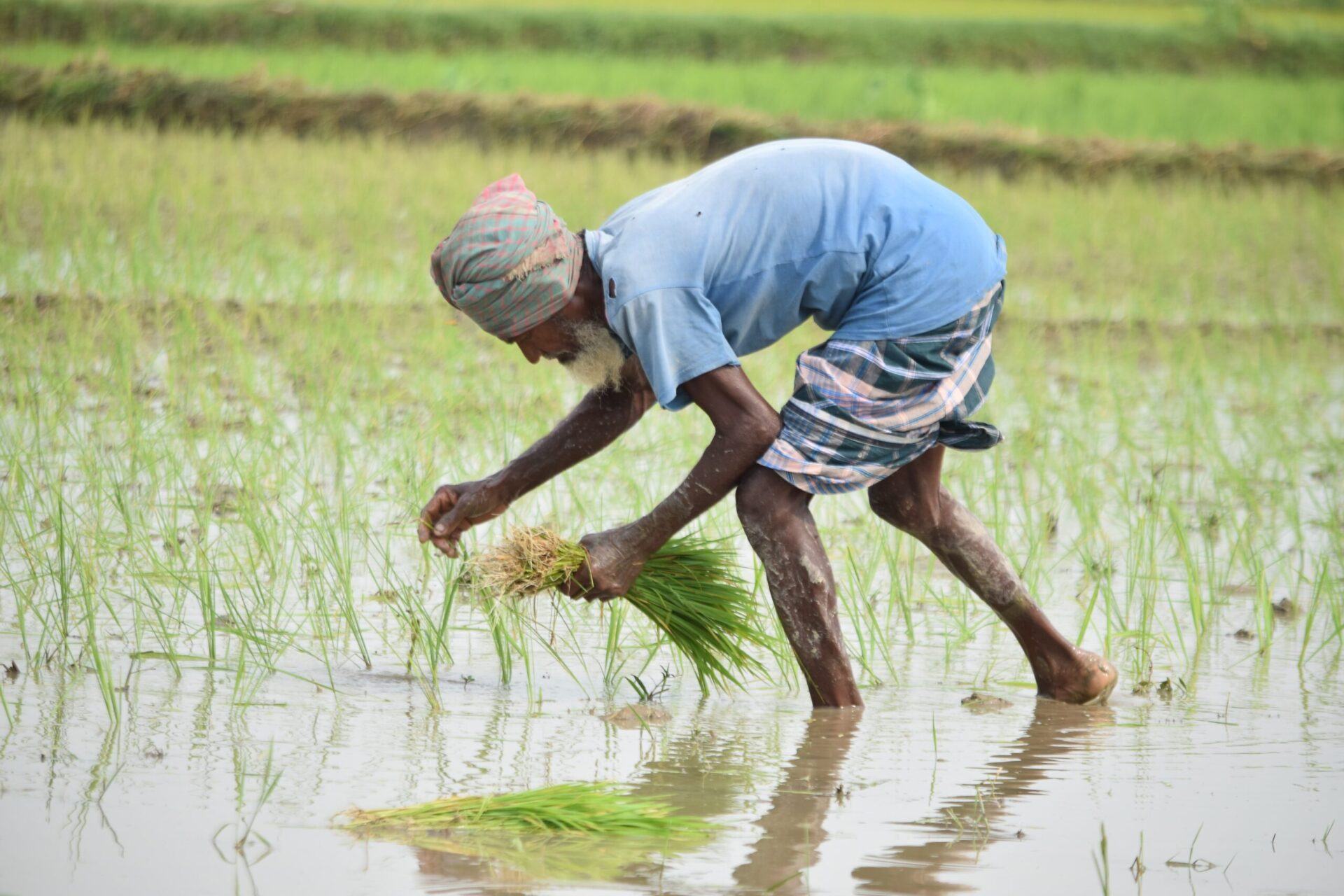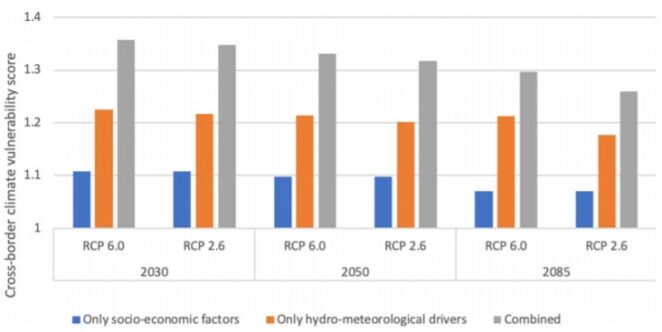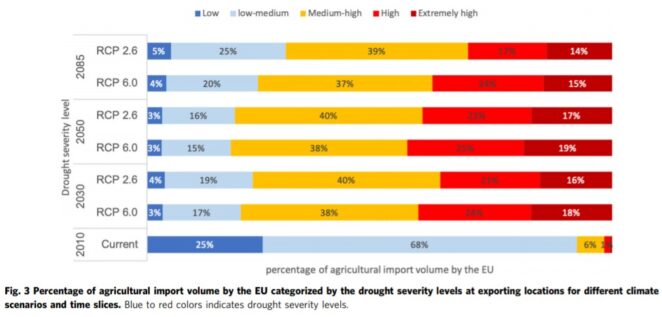Cross-border climate vulnerabilities of the European Union to drought

Introduction
European Union’s vulnerability to climate change stretches far beyond its borders because many of its economic sectors, such as meat and dairy, use raw materials sourced from far afield. This product flow through international trade means that these sectors are vulnerable to extreme weather events and climate change in the original production regions. Should drought occur in the regions that produce the food imported by the EU, it would disrupt supply. As a result, commodity prices would change, which could lead to economic damage and social disruption within the EU.
This article quantifies these climate vulnerabilities with a focus on drought risk and assessed them for 2030, 2050, 2085 and for RCP 2.6 and 6.0. It finds that the EU’s agri-food economy will become highly vulnerable to drought outside its borders due to climate change, indicating that supplies of key imported crops could be disrupted, with potential impacts on food prices. Around 44% of the EU’s agricultural imports are sourced from locations that are set to become highly vulnerable to drought as a result of climate change. The most affected crop imports are identified to be soybean, oil palm, cocoa, coffee and sugar cane.
The study concludes that there is a clear and urgent need for further GHG emissions reductions, along with more comprehensive adaptation and mitigation strategies to reduce the EU’s vulnerability to drought in the near future.
*A summary of the study can be found below. Download the full publication from the right-hand column for more details.
Outcomes and Impacts
Cross-border climate vulnerabilities of the EU to drought
Global climate change will make the EU’s agri-food economy more vulnerable to drought in non-EU countries in the future. The cross-border climate vulnerability score of the EU’s agri-food economy to drought (CCVS) for 2030, 2050, and 2085 under RCP 2.6 and RCP 6.0 concentration pathways, falls between 1.20 and 1.35 (see figure below extracted from the study). It means that the total amount of agricultural imports by the EU will be 25–35% more vulnerable to drought in the future compared to the current situation mainly because of change in drought severity, increased intensity, and duration of drought events, in the production locations of the imported products.

Drought severity level of the EU’s agricultural imports
Under the current climate around 93% of the agricultural imports to the EU come from locations with a low/low-medium drought severity. The rest (7%) are categorized as medium-high and high. This alters significantly under climate change, in 2050 under the RCP 6.0 concentration pathway, only 18% of the EU’s agricultural imports come from locations with low drought severity and around 44% of the imports come from areas that will experience high and extremely high drought severity (see figure below extracted from the study).

Cross-border climate vulnerability of the EU: key-imported crops
Of the eight most important crops imported to the EU, some are far more vulnerable to drought than others. For example, under both medium and low GHG emissions scenarios in all the years studied, sunflower seeds and maize remain at low risk of drought. In contrast, soybeans become moderately vulnerable, and coffee, cocoa, sugar cane and palm oil imports become high or very highly vulnerable to drought (with the exception of cocoa, which decreases slightly in vulnerability in 2085).
Discussion
The analysis shows that crop product flow through international trade means that all sectors which use raw materials through global supply chains are connected to water resources—and to extreme weather events and climate change—in the original production regions. As the intensity and magnitude of extreme weather events will alter under a changing climate, sectors in the EU that are dependent on this external product flow will become more vulnerable to extreme weather events.
EU-wide climate-related strategies, such as the Climate Adaptation Strategy and the EU’s agricultural trade policy, as well as international development strategies at the pan-European and regional level, can benefit from the results of this assessment. They could further address these cross-border climate vulnerabilities on a sectoral basis in order to prevent any negative consequences that the EU economy may face. The EU can also use the outcomes of this study when developing bilateral relations with trade partners.
One of the other key outcomes of this study is that the vulnerability of the EU’s agricultural imports to drought sharply increase within the next twenty to thirty years. This suggests that immediate action is needed to prevent the possible negative impacts.
The outcomes of the study also revealed that adaptive capacities to climate change can play a key role in reducing vulnerabilities in CCVSs as observed in the USA, Indonesia, and Malaysia. Despite higher drought severity in the future, vulnerability scores for the imports from these countries are estimated lower because of their higher climate change adaptive capacities. However, most of the agricultural imports by the EU such as soybean (Brazil) and cocoa (Ivory Coast and Ghana) are produced in areas with low adaptive capacity to climate change. Working towards more climate-resilient production in these countries can be a meaningful step for the EU in order to reduce its cross-border climate vulnerabilities.
Conclusion
In the near future, supplies of certain crops to the EU could be disrupted due to increased drought in other parts of the world. Coffee, cocoa, sugar cane, oil palm, and soybean are the most climate-vulnerable imported agricultural products by the EU. A large portion of these imports will come from areas with high drought severity in the future.
The EU’s economic dependency on goods produced in regions that are vulnerable to water-related climate impacts can be considered in government policies and business strategies. The strategic importance of some regions, such as Southeast Asia and South America, will increase for the EU regarding the potential climate-induced impacts on water resources and the need for a continuous supply of commodities from these regions. Investments, such as increasing drought resilience and strengthening water governance to ensure sustainable, efficient, and equitable water use, could reduce the cross-border climate vulnerability of the EU’s economy. The EU’s policy and producers can also find alternative production options.
Suggested citation
Ercin, E., Veldkamp, T. I. E., & Hunink, J. (2021). Cross-border climate vulnerabilities of the European Union to drought. Nature Communications, 12(1), 3322. https://doi.org/10.1038/s41467-021-23584-0
(0) Comments
There is no content